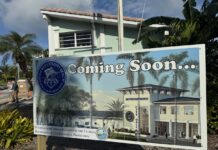
Mathew Perry planted the American flag at Key West in 1822. Commodore David Porter was instructed to establish a military depot on the island the following year unless he could identify a more suitable locale.
Porter could not and, in a General Order issued from the USS Peacock on April 6, 1823, he wrote: “A Salute of 17 guns is to be find (fired) at 8 o’clock this morning from the Battery in front of the Town, and the American Ensign is to be hoisted at the Flag Staff… The Town is hereafter to be called Allenton, and The Battery, Thompsons Battery.”
On July 2, 1823, Monroe County was established as the Florida Territory’s sixth county and named after the then-sitting and fifth president of the United States, James Monroe. County boundaries originally extended north to the southern shore of Lake Okeechobee and west to Charlotte Harbor.
Two days later, the 1823 Wrecking Act was passed by the Legislative Council of the Territory of Florida; George Murray was president. Among the act’s 14 parts were statutes requiring the salvaged property to be reported to the nearest justice of the peace or notary public. Additionally, it would prove the officer’s duty to oversee the assembly of a five-member arbitration jury to decide all fees for the salvage operation. Section 14 of the act stated, “Be it further enacted, That if any person shall within this territory, make or hold out any false lights, or make any device, or do any other act or thing with intent to mislead, bewilder or decoy the mariners of any vessel on the high seas, whereby such vessel may be cast ashore, or get aground, such person or persons so offending, and every accessory thereto, shall on conviction thereof be deemed guilty of Felony, and shall suffer death.”
Tales of skullduggery and “false lights,” while pervasive in wrecker lore, were rarely documented. When Dr. Benjamin B. Strobel, a physician, and writer who traveled extensively through the Keys in 1828, observed the wreckers, he wrote: “From all that I heard of wreckers, I expected to see a parcel of low, dirty pirate looking crafts, officiated and manned by a set of black whiskered fellows, who carried murder in their very looks. I was, however, very agreeably surprised to find their vessels fine large sloops and schooners, regular clippers, kept in first rate order, and that the Captains were jovial, good humored sons of Neptune, who manifested every disposition to be polite and hospitable, and to afford every facility to persons passing up and down the Reef. The crews were composed of hearty, well dressed, honest looking men.”
On the back of the wrecking industry, Key West grew into the wealthiest city per capita in the developing United States. In 1828, the southernmost city became the first in Monroe County to become incorporated. At the time, a second community was beginning to flourish in the Upper Keys on the relatively small 11-acre Indian Key. A general store, the only one found along the island chain outside Key West, opened in 1824. From there, Indian Key developed into the most important island in the Florida Keys, not named Key West.
By 1835, Indian Key was home to a community of as many as 140 people. It was 1835, too, on Dec. 28, when separate Indian factions attacked encampments at the Withlacoochee River, located northeast of Tampa, and at Fort King, located at what is today Ocala, and ignited the second escalation of the Seminole War. Between 1836 and 1840, Monroe County experienced several acts of hostility, including attacks at the New River (Fort Lauderdale), Cape Florida Lighthouse (Key Biscayne), Key Largo and Tavernier Key.
The southernmost attack during the second escalation of the Seminole War occurred at Indian Key on Nov. 7, 1840. Six lives were lost. When that tragic event occurred, Indian Key was no longer a part of Monroe County. In 1836, Dade County was carved out of the existing boundaries of Monroe County and included land from the shore of Lake Okeechobee to Bahia Honda in the Lower Keys. Because Indian Key was the largest community in the new district, it was assigned as the county seat.
Indian Key did not remain a part of Dade County for long. The vast majority of the Florida Keys were returned when county lines were redrawn in 1866, and the modern demarcation, at least in the Florida Keys, became Broad Creek. Broad Creek is found in the Northern Keys, and flows between the Swan Keys and a collection of small islands immediately north of Key Largo.
By 1885, Monroe County was still an extensive piece of real estate and included what are today southwest Florida’s Lee and Collier Counties. While we could go on for pages, chapters and books about the last 200 years, it is going to take more than a single column to encapsulate two centuries of local history, which is why I am going to spend the entire month of July highlighting just a smidge of it.
The year 1885, by the way, is when the second city was ever incorporated in Monroe County.
That city was Fort Myers, the county seat of what is now Lee County.



















